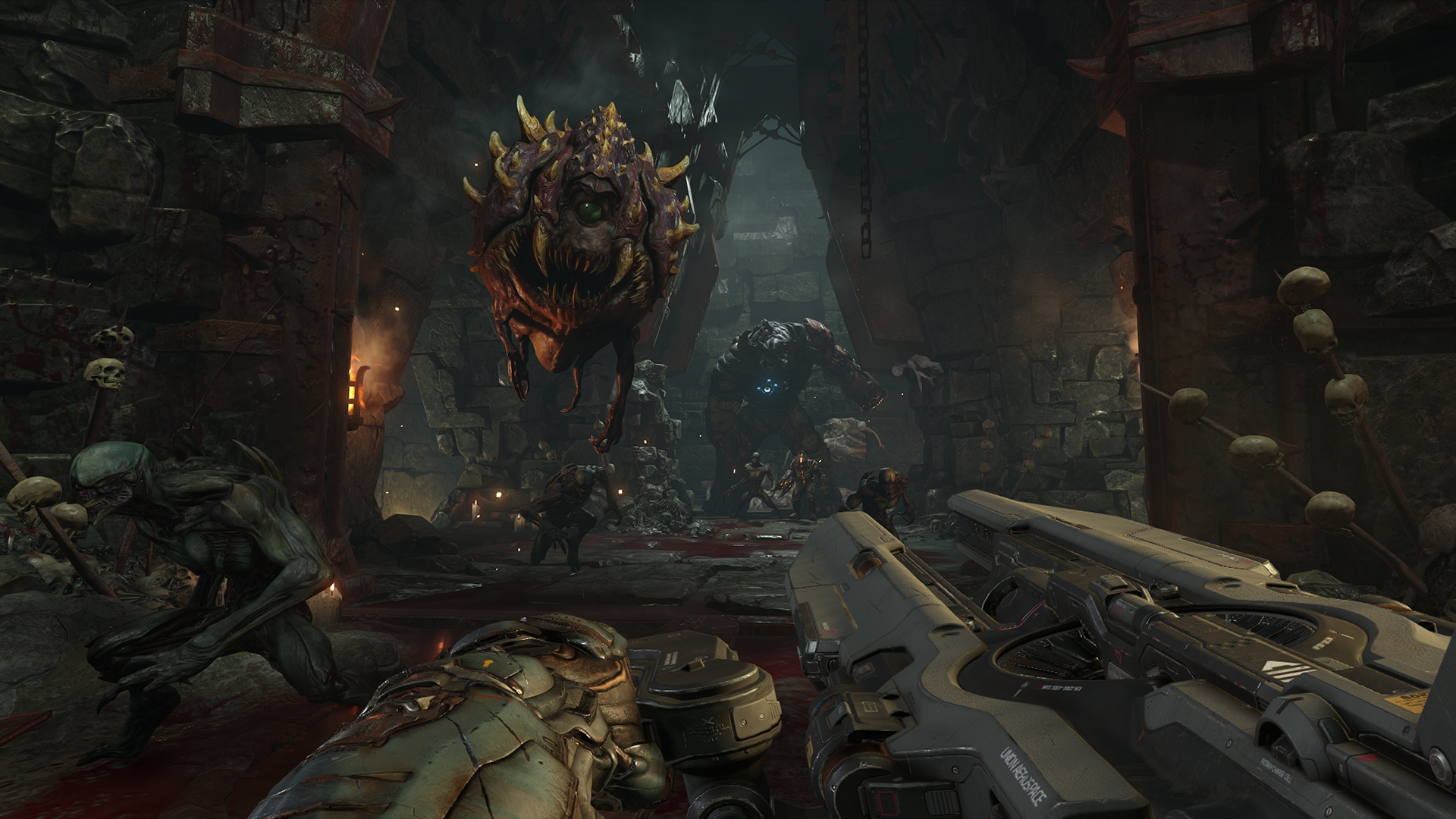The Doom beta is already the most exciting FPS of 2016
The Doom beta – which finished on Monday, but we’ve just heard is restarting next week - had two game modes. It had two maps. It had (probably) the full multiplayer weapon-set, but only three pieces of special equipment - read: grenades and teleporters - and one of the playable demons that will be in the final version. But I played it for a full nine hours on Saturday, and even that wasn’t enough.
The ostensibly limited number of options didn’t matter. The game at the core of those options – its every interactive element tuned up to deliver escalating, moment-to-moment glee through its thoughtful, free-form carnage – was everything I needed. In fact it felt so complete, so robust, so rich and fully formed, that I can’t quite believe it’s gone away.
At this point, I need to start explaining myself, because if you weren’t in the beta, or only had time for a short dabble, I probably sound like a lunatic.
Doom remembers why first person shooters were exciting in the first place. Principles of exhilarating movement, tempered by tactile and precise control. Principles of unique and exciting weaponry that feels good the instant you pull the trigger, but which is also clear and specific in its strategic purpose, and just makes Really Cool Things happen whenever shots connect. Principles of intimate, fast, strategic one-upmanship between players, where quick reflexes are no more important than quick thinking, and the reward for engaged play is not only a successful kill, but a moment of thrilling back-and-forth interaction.
Doom is a game that really, really understands what has made us love first-person shooters all along, and the way it distils and repackages all of that for 2016, in an effortlessly console-friendly fashion, is just wonderful. In fact, it’s borderline witchcraft.
If the above gameplay description sounds more like the high-flying speed of Quake than a traditional Doom deathmatch, that’s because it is. And that makes sense. Still going strong on PC as Quake Live, in terms of pure, gameplay-driven arena shooters, Id’s 1999 rampage is still hard to beat. But the really unfathomable thing is just how well the most notoriously ‘keyboard and mouse only’ shooter has been translated for console play.

Previously an experience that was logistically cut off from non-PC players due to the generally accepted inability of a controller to accurately keep up with the pace – Quake Live’s Xbox 360 port was a notorious waste of time, but Doom’s version of Quake’s brilliant conceits just works. The game hasn’t been dumbed down. It has lost none of the vital, exciting, second-to-second, improvisational heroism. It’s just that this version of DoomQuake has clearly been built with the 2016 player in mind, from controls, to systems, to wider functionality. It’s clear throughout though, that the modern landscape is serving the original game idea, and not the other way around. The concessions that have been made are all smart and well-considered, designed to optimise rather than dilute.
Sign up to the GamesRadar+ Newsletter
Weekly digests, tales from the communities you love, and more
You’ll unlock weapons progressively at first, but you’ll have the lot within a couple of hours. This level-based gearing up isn’t there to infuse the game with artificial incentives to play, but rather to gradually introduce the player to Doom’s flamboyant weapon-set, and the strategically important, creative joys of experimenting with cleverly complementary load-outs. Every gun in Doom is a monster designed to kill its prey in a certain fashion, and every one is brilliant fun. But you’ll be a lot more effective when, say, using the Super Shotgun straight after drowning your enemies with a radioactive goo splash from the Plasma Rifle’s secondary fire, than if you sprint in to deliver the buckshot following a mid-range machine gun salvo.
The same goes for the system of load-outs itself. Many old-school Quake players might balk at the inability to carry every gun in the game at the same time – or at least collect them on the fly at timed spawn points – but again, there’s good reason for the change. Aside from further encouraging focused experimentation with weapon strategies, it also softens the older games’ demands on anally retentive map-knowledge and weapon camping.

High-level Quake play can often become a race to the best guns, timed runs around the map to each incoming weapon tipping the balance between the haves and the have-nots. Doom is a lot more fair and balanced in that regard, letting everyone play just how they want, though it does recognise the worth of map control, and reconfigures it in a more immediate, friendly way.
The Demon Rune and Gauss Cannon – which spawn into Team Deathmatch on a timer, and allow players to both transform into an uber-powered demon and combat it, respectively – are a great nod to Quake’s strategic conceits without beating you over the head with them. They encourage a frantic dash toward certain points on the map, leading to great, sporadic clusters of group battle. They can result in hilarious set-pieces, as camping players have the Rune snatched out from under their noses by a cheeky, kamikaze runner with really lucky timing. And crucially, they happen infrequently enough that they never become the focus of the match, instead remaining a welcome dash of organised punctuation to Doom’s giddy excesses.
All this means that Doom remains wide open to explore, play, and just enjoy. That’s the treatment that its particular brand of combat requires. This is heady, fast, exciting, funny stuff, in which lone wolves can excel as easily as players with wingmen. It’s a game in which reservation leads to death, and experimental, extravagant, expressive play brings success, or at least such a good time that you won’t care about failure.

Die, and you’re straight back in, death less a penalty than a slap on the wrist and a swift, easily understandable lesson about the situation that killed you. There’s no sadness in Doom. There’s no downtime. There’s just energy and feedback and fun. Every action you make matters, and everything you do feels great.
Because Doom’s multiplayer delivers an experience that’s long been missing from the online arena, one that serves only the experience of play, in its most direct and exciting. If the beta’s structure is to be taken as an indication of the final product – and it seems likely that it should be – Doom is not concerned with lengthy progression paths or protracted unlock systems. It doesn’t want to pressure or guilt you into grinding. It simply wants to get you in, as fast as possible – at the start of every game and after every death – and get you having fun. And it wants to keep you having fun. And good Lord, is it fun. I miss it already.



